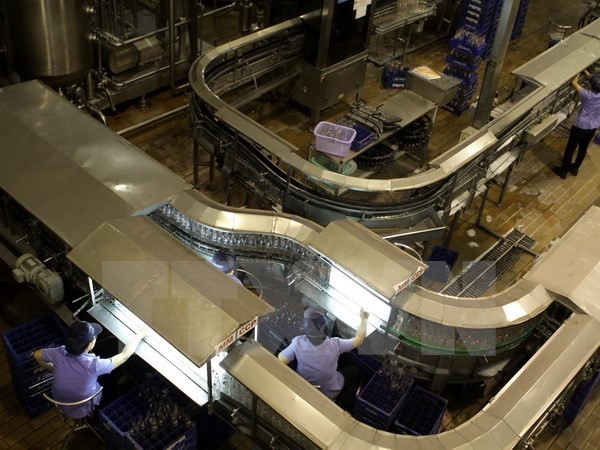(VOVworld) – In the first half of this year, Vietnam’s economy showed signs of rallying. The macro economy stabilized and GDP increased 5.52%. Although the growth rate is lower than last year, it has been steady, thanks to the growth of industrial production and domestic retail sales.
 |
| Workers produce bottled beverage at a factory of Suntory Pepsico Vietnam in Tra Noc 2 Industrial Park, Can Tho city (Photo: VNA) |
In the first half of 2016, Vietnam’s economy was strongly affected by the decline of many major economies around the world. Domestically, it faced great losses due to natural disasters. The Mekong Delta region suffered its worst drought in almost a century. In Vietnam’s northern provinces cold spells killed thousands of cattle and crops. Southern provinces suffered saline intrusion which devastated agricultural production.
Doctor Nguyen Xuan Thanh, director of the Fulbright Economics Teaching Program in Ho Chi Minh City, said: “By the end of last year, we were quite optimistic about the recovery of economic growth. But in the first half of this year, Vietnam found it hard to reach its economic growth target despite the government’s drastic efforts to improve the business and investment environment. It’s partly due to the slow growth of the global economy, specifically global trade, but other difficulties have slowed the growth of Vietnam’s agricultural sector this year.”
Over the past six months, Vietnam’s consumer price index (CPI) rose more than 1.7% compared to the same period last year. The Index of Industrial Production (IIP) for the processing and manufacturing industry increased more than 10%. Retail sales and service revenue posted an increase of 9.5%.
During the remaining months of this year when Vietnam will fully implement several free trade agreements, its export markets are likely to expand, creating an opportunity for export revenues to rise, particularly from farming and aquatic products. According to the Ministry of Industry and Trade, Vietnam’s exports might grow 8.5% for the year.
Foreign direct investment attraction grew strongly, with total disbursed capital more than 7.2 billion USD, up 15% over last year. The total registered FDI reached 11 billion USD, double last year’s total at this point.
Doctor Nguyen Duc Thanh, Director of the Vietnam Institute for Economic and Policy Research, says reaching the target will require greater efforts by the government, ministries, sectors, provincial authorities, and businesses.
The government should outline policies in accordance with the reforms of the public administrative system and strengthen links between ministries and sectors. Domestic enterprises should make full use of promulgated policies and international economic commitments set in free trade agreements.
According to Thanh, “what we need now is policies, the implementation of these policies, a mechanism for policy enforcement towards reducing the scattered management among ministries and provinces. We also need a fair competitive environment for businesses and a council to prevent the development of monopolies or factionalism. We should also improve the quality of the labor force and find new ways to provide qualified personnel for industries.”
At the end of the government’s monthly meeting for June, Prime Minister Nguyen Xuan Phuc said: “First, we should improve the business environment and ministries, sectors, and province should realize the government resolutions. Second, we need to step up the disbursement of investment capital and support for farmers in the Mekong Delta, south central, and central highlands region to revive agricultural production, especially the third crop to ensure social stability and security. In addition, we should expand export markets and stimulate domestic consumption.”